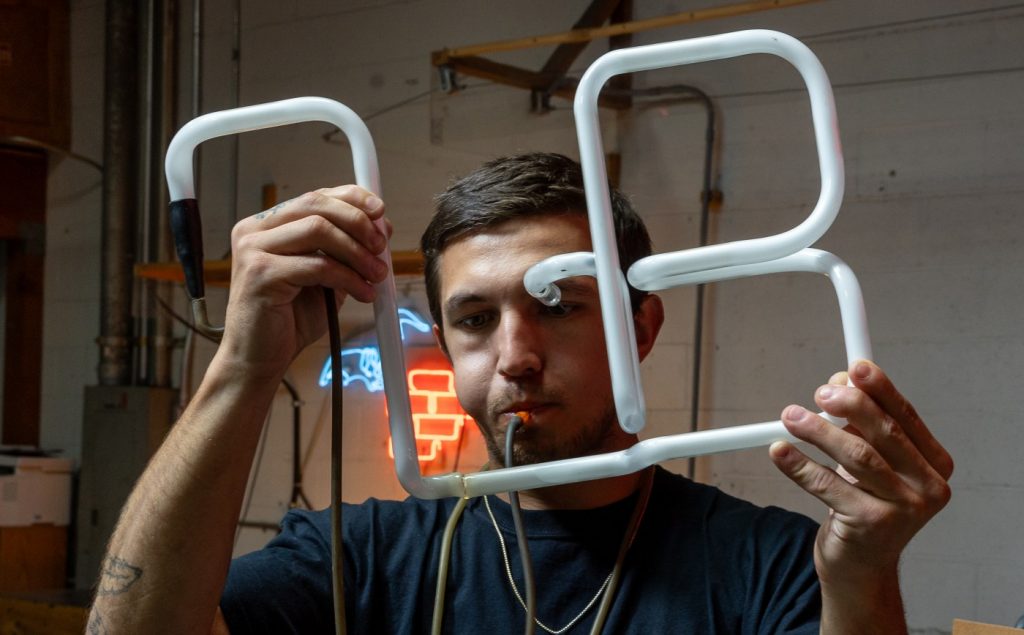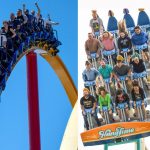Enter the nondescript Neon Works warehouse in North Oakland, and you’ll find yourself suddenly immersed in rainbow light. It’s as if a time-warping tornado from the 1950s Bay Area wrapped all the neon signs up and dumped them in one place – gleaming banners for Carl’s Pastry, Kane’s Coats and Furs and Kilpatrick’s Bakeries, which baked bread for the World War II effort.
The collector behind these glowing artifacts is Jim Rizzo, who runs the company with his wife, Kate, and two other artisans. Neon Works has fabricated and repaired neon signs for more than three decades. Over his career, Rizzo guesses he’s touched every neon sign in San Francisco at least once.
“All these places were mom-and-pop businesses that raised their families off of that business, which is what I’m doing,” he says. “I just feel the hard work and love of having their names in neon, like, ‘Here’s my store, here’s my pride.’”
There was a time when the Bay was basked in the soft glow of this noble gas, an oasis of light in the nocturnal murk beaming atomic number 10 into space. It’s thought the very first neon sign in America was erected in San Francisco in 1923 for a car dealership on Van Ness Avenue. Market Street in the 1950s was a blazing anaconda of neon, bathing moviegoers at the Orpheum Theatre and shoppers at the Crystal Palace Market, and Chinatown enjoyed its own mysterious hodgepodge of cocktail and chop-suey signs.
Jim Rizzo’s Neon Works studio in Oakland, Calif. has been restoring vintage commercial signs in the Bay Area for decades. On Wednesday, Aug. 28, 2024, he stands by a modern one designed for his very own business. (Karl Mondon/Bay Area News Group)
Related Articles
San Jose woman creates ‘selfie wonderland’ for visitors to Imaginarium
13 holiday gift ideas for the Bay Area foodies and fun seekers on your shopping list
The sensational Sensorio light display in Paso Robles adds new exhibits
Before the Eiffel Tower, there was the world-famous San Jose Electric Light Tower
Art, light, healing: Illuminated sculptures welcome patients to Walnut Creek hospital
That special glow is now greatly diminished, thanks to government policies that dismantled neon signs and the invasion of cheaper alternatives like LEDs. (Don’t get a neon worker started on LEDs.) But if you know where to look — in the niches of industry, preservation and high art — you’ll find the Bay Area’s neon culture bravely flickering on today.
There used to be tons of neon-fabrication shops around the Bay, with a Yellow Pages from the 1950s showing two full pages of company listings. Now, Rizzo’s operation is perhaps the only one of its size still in existence that’s 100 percent devoted to neon. But the pandemic did a number on the economy, which affects signs, too.
“If businesses aren’t opening, they’re not buying signs, and even the ones that are opening aren’t spending as much money as they used to,” he says. “I think the love of neon is still there, but because budgets are tight, people are going to LED fake neon. Have you seen that stuff? It’s trying to look like neon, but it’s plastic with little diodes embedded in it. … Nobody makes it in America.”
Neon Works handles about 100 jobs a year for restaurants, bars and hotels that want the comforting, nostalgic glow of neon. Recent customers include the Castro Theatre in San Francisco, which restored its iconic blade sign and marquee, John’s Grill off Market Street and the Freight & Salvage music hall in Berkeley.
Rizzo handles the installations, which means he often finds himself hanging 16 stories up in a bosun chair tinkering with hotel signs. He can handle the dizzying elevation: “I love heights.” What he can’t stand are the pigeons.
“I will kill a pigeon in a heartbeat, I hate them,” he jokes. “The Avenue Theatre sign (in San Francisco) was so dilapidated and filled with pigeons that every day we pulled up to it, we were just like, ‘Uhhhhhgh.’”
The tube bender at Neon Works is Adam Taylor, who moved out to the Bay specifically to work with neon after getting his B.F.A. on the East Coast. “Tube bending” is the term for heating and shaping neon tubes with almost medieval-like flame torches – the trade is full of such wonderful terms, including “slumping” (when a tube sinks down from gravity), “blockout paint” (black pigment used to create the illusion of letter breaks) and “bombarding” (electrifying a tube to clean out impurities).
Adam Taylor, a glass bender at Neon Works, attaches an electrode to a sign under construction on Wednesday, Aug. 28, 2024, in Oakland, Calif. (Karl Mondon/Bay Area News Group)
The trade also has its own unique challenges. “Funny story: My first day here, I lit myself on fire,” says Taylor, who’s had to seek medical attention at least twice for bending-related injuries. “One was a bad slice on the forearm – I still have a scar – and the other was a bad cut on my thumb, which I got glued up at urgent care. Burns and cuts are normal – comes with the job.”
Taylor guesses there are fewer than a dozen people in the Bay doing commercial tube bending. It’s a highly specialized job — and one he loves despite the pain.
“I think it’s very rewarding to work with your hands every day and actually have something physical in front of you,” he says. “And in a roundabout way, it gives back to the city and environments by giving certain neighborhoods feelings or a vibe. Just driving around randomly through San Francisco or Oakland, I can be like, ‘Oh, I did that! I did that!’”
Two people dedicated to preserving those vibes are Al Barna and Randall Ann Homan, whose nonprofit San Francisco Neon is devoted to advocating for the artistic legacy of neon. They have helped the city’s government draft best practices when it comes to preserving historically significant signs and have saved many from decrepitude or the junkyard, including Portola’s Avenue Theater, the Abigail Hotel in the Tenderloin and Li Po Cocktail Lounge in Chinatown.
“Neon got a really bad reputation during the (post-war) flight from the downtowns, which left all those signs in disrepair and associated with blight,” says Homan. “One of the biggest reasons in removing them was Lady Bird Johnson, whose scrap-old-signs campaign (aka the 1965 Highway Beautification Act) actually paid people to take down neon signs. It was an effort to modernize America’s main streets and was so prevalent and successful, it’s a miracle we have any neon signs left in our cities.”
When Homan and Barna assist in restoring a sign, they and the sign’s owner typically hold a “lighting ceremony” at the end, flipping the switch as gathered crowds cheer – such is the compulsion of neon.
“Different signs in different neighborhoods work like sponges, they soak up local history and become landmarks, even after the theaters and shops disappear,” explains Homan.
“And the fact it’s glass, gas and electricity all in one finished product and also that it’s all handmade – the technology hasn’t changed much in over 100 years,” adds Barna. “Electronics have become more sophisticated, but that doesn’t mean they’re better. The quality of the noble gasses are hard to match. There’s no other light source like it.”
Neon isn’t just a vehicle for advertisement or placemaking, though. A small but vibrant arts movement has sprung up around the medium, which in the Bay Area is arguably led by She Bends, a creative project run by Meryl Pataky and Kelsey Issel. She Bends puts on shows – check out its curated exhibit “Neon as Soulcraft” at San Francisco’s Museum of Craft and Design, through Nov. 24 – and pushes for more exposure for female and underrepresented artists in the male-dominated field of neon.
Meryl Pataky works on a ladder in her She Bends studio with Kelsey Issel on Thursday, Aug. 29, 2024, in the old Hamm’s Brewery building in San Francisco, Calif. (Karl Mondon/Bay Area News Group)
“Neon is not seen so much as a fine art form. That’s one of things She Bends tries to shift perspective on – we’re showing audiences it can be more than just a sign,” says Pataky, who does things like balance stone blocks atop deceptively strong neon tubes and weave an immense hanging quilt from shattered scrap glass.
What attracts Pataky to neon? It’s certainly not the collectors, a relative rarity in the Bay Area.
“It’s a technology, a craft and an art form, and a relatively new one compared to most,” she says. “The science behind getting it to light up looks very complicated, but in fact is simple – it’s ionized glasses inside a low-pressure evacuated tube. So it’s essentially the same thing we see in the cosmos, in nebulae, and that is very primordial. You can literally create light, which feels like a magical thing to do.”
Pataky can count on one hand the number of neon artists operating around the Bay. That might change in the near future, though, as there appears to be a growing curiosity.
“I think the interest is going away from people sitting at a computer all the time toward wanting to do things with their hands – nurturing those crafts that went away and are now making a resurgence, like making handmade jeans and manufacturing parts for machinery,” says Shawna Peterson, a neon artist and sign maker in the Sierra Foothills. (She recently redid the sign at Albany’s beloved dive bar, the Hotsy Totsy Club.)
An array of glass tubes are neatly stored at Neon Works studio on Wednesday, Aug. 28, 2024, in Oakland, Calif. (Karl Mondon/Bay Area News Group)
Peterson is part of a nationwide group trying to create a nonprofit that will offer course training for new artisans, so they can go from dipping a toe into neon to becoming full-blown wizards of glowing glass.
“One of the things that concerns me is neon has a high learning curve, so there are people who get into it but then lose faith and get frustrated,” she says. “I’m just hoping they stay dedicated and continue so there are more generations that pick up the torch. Literally.”


